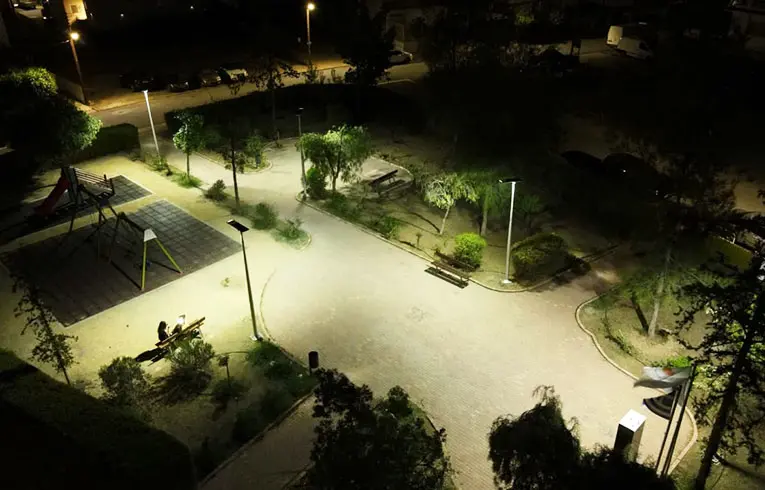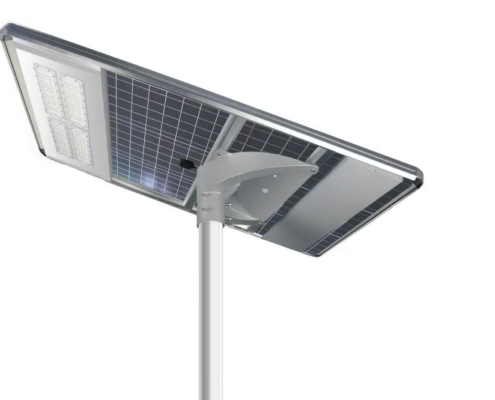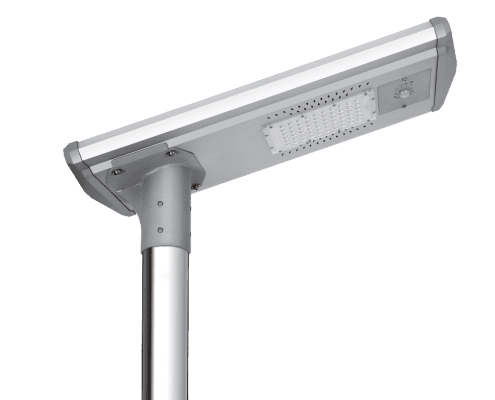How to Design School Solar Street Lighting
This guide provides a detailed framework for designing solar-powered street lighting systems for university campuses. Based on leading international standards like CIE, EN 13201, and ANSI/IES, it covers core elements including illuminance levels, luminaire efficacy, color temperature, pole design, system configuration, and cost-benefit analysis, all tailored to the unique safety and aesthetic needs of a campus environment.

1. Lighting Performance and Design Standards
1.1 Illuminance (Lux) and Uniformity
Proper lighting levels are critical for pedestrian and vehicle safety on campus.
- Main Roads: An average horizontal illuminance (E_avg) of ≥10 lx is required, with an overall uniformity (Uo = minimum illuminance / average illuminance) of ≥0.4. This ensures consistent lighting, preventing visual fatigue and dark spots that pose safety risks.
- Secondary Roads & Pedestrian Paths: An average illuminance of ≥5 lx with an overall uniformity (Uo) of ≥0.3 is sufficient.
- Intersections & Stairways: These areas require enhanced vertical illuminance (recommended ≥10 lx) to improve facial recognition and the visibility of obstacles.
1.2 Luminous Flux (Lumens) and Efficacy
- Lumen Calculation:
Required Lumens per Lamp = [Target Illuminance (lx) × Illuminated Area (m²)] ÷ [Utilization Factor × Maintenance Factor]. The combined factors typically range from 0.6 to 0.7.
Example: To achieve 10 lx over a 30m x 5m road section (150 m²), a luminaire would need approximately (10 × 150) / 0.6 ≈ 2,500 lumens. - Efficacy Requirement:
Solar LED luminaires should have an efficacy of ≥120 lm/W to maximize energy conversion and minimize system size.
1.3 Color Temperature (CCT) Selection
- Recommended Range: 4000K – 5000K (Neutral White to Cool White).
- Rationale: 4000K provides a balance of visual clarity and comfort, mimicking natural daylight. 5000K offers a crisper light, suitable for areas requiring higher alertness, like parking lot entrances.
- Crucial Tip: Avoid CCT above 6000K. The high blue light content can cause glare and visual fatigue.
1.4 Color Rendering Index (CRI)
- Standard: A minimum of Ra ≥80 is the baseline requirement.
- Recommendation: For areas near laboratories, art buildings, or security checkpoints, a higher CRI of Ra ≥90 is recommended to ensure accurate color perception of objects, signs, and potential hazards.

2. Structural Design and Specifications
2.1 Pole Height and Spacing
| Road Type | Pole Height | Installation Spacing | Reference LED Power |
|---|---|---|---|
| Campus Main Roads | 6–8 m | 20–30 m | 60–80 W LED |
| Secondary Roads / Bike Lanes | 4–6 m | 15–25 m | 40–60 W LED |
| Pedestrian Walkways | 3–4 m | 10–15 m | 20–30 W LED |
Key Design Points:
- The height-to-spacing ratio should be ≤3.5 to ensure adequate light overlap and meet uniformity standards (e.g., a 6m pole should have a spacing of ≤21m).
- On curved roads, reduce spacing by ~20% to eliminate dark zones.
2.2 Pole Material
- Primary Choice: Hot-dip galvanized steel (Q235 grade with a wall thickness ≥3.5mm). This offers excellent corrosion resistance, can withstand ≥Force 12 winds, and has a design life of over 20 years.
- Alternatives: Aluminum alloy (lightweight and aesthetic but costlier) or concrete composites (durable but difficult to transport and install).
2.3 Photovoltaic (PV) Panel and Battery Configuration (Corrected Section)
This is the most critical calculation for a reliable solar lighting system.
- PV Panel Sizing Formula:
PV Panel Power (Wp) ≥ (Daily Energy Consumption (Wh) × Redundancy Factor) ÷ Local Peak Sun Hours (h)
Example: For a 60W luminaire with a smart profile (e.g., 4 hours at 100% and 6 hours at 30%), the equivalent full-power runtime is 6.8 hours.
• Daily Consumption = 60W × 6.8h = 408 Wh.
• Required Daily Generation (with a 1.5 redundancy factor) = 408 Wh × 1.5 = 612 Wh.
• Assuming 4.0 average peak sun hours: PV Panel Power ≥ 612 Wh / 4h = 153 Wp. A 160Wp or 180Wp panel is recommended. - Battery Capacity Sizing:
Battery Capacity (Wh) ≥ Daily Energy Consumption (Wh) × Days of Autonomy
Example: For 408Wh daily consumption and 3 days of autonomy (for rainy/cloudy weather):
• Required Battery Capacity ≥ 408 Wh × 3 days = 1224 Wh.
• Using a 12.8V LiFePO4 battery system: Capacity (Ah) = 1224 Wh / 12.8V ≈ 96 Ah. A 12.8V/100Ah battery pack is a suitable choice.
3. Intelligent Control System Design
3.1 Automated Lighting Strategies
- Time-Based Dimming: Program the controller to adjust brightness based on typical campus activity.
- 18:00 – 22:00 (Peak Hours): 100% brightness.
- 22:00 – 06:00 (Off-Peak Hours): Dim down to 30%-50% to conserve energy.
- Motion Sensing: Integrate a microwave or PIR sensor (with a detection radius ≥10m). When a pedestrian or vehicle is detected during off-peak hours, the light instantly brightens to 80-100% and returns to dim mode after a set delay.
3.2 Remote Fault Monitoring
Utilize IoT technology (e.g., LoRa/NB-IoT) to network the lights. This allows a central platform to monitor real-time data like voltage, charging efficiency, and lamp status, enabling proactive maintenance and fault alerts.
4. System Optimization and Cost-Benefit Analysis (Revised Estimates)
4.1 Initial Investment Breakdown (Estimate for 100 Units)
| Item | Unit Cost (USD) | Total Cost (USD) |
|---|---|---|
| Solar LED Luminaire (incl. battery & controller) | $250 – $400 | $32,500 |
| 6m Hot-Dip Galvanized Pole | $120 – $200 | $16,000 |
| Foundation & Installation Labor | $60 / unit | $6,000 |
| Total Estimated Investment | $54,500 |
4.2 Operational Cost Savings
- Electricity Savings: A solar light replaces a conventional 100W HPS lamp (consuming ~120W with ballast). Running 10 hours/day, the annual savings per light are approx. 1.2 kWh × 365 days × $0.15/kWh = $65.7/year. Solar lights have $0 electricity costs.
- Maintenance Savings: With no cables to inspect and long-life LEDs (50,000+ hours), maintenance is drastically reduced. Compared to frequent bulb/ballast replacements, costs can be lowered by 50%-70%.
4.3 Return on Investment (ROI) Estimation
- Annual Savings per Light (Est.): $65.7 (Energy) + $35 (Maint. Savings) ≈ $100.
- Investment per Light (Est.): $545.
- Estimated ROI: ~$100 / $545 ≈ 18.3% per year.
- Payback Period: Approximately 4 to 6 years.
4.4 Recommended Maintenance Schedule
- PV Panel Cleaning: Every 3-6 months in dusty areas to maintain charging efficiency. Rain is often sufficient in other climates.
- Battery Health Check: Monitor via the remote system. A physical spot-check is recommended every 2 years. LiFePO4 batteries typically have a design life of 5-8 years.
5. Design Process and Implementation Recommendations
- Prioritize Lighting Simulation: Use professional software like DIALux during the design phase to create a simulation. This validates that the proposed layout meets all illuminance and uniformity targets before purchase.
- Validate with a Pilot Project: Install a small number of units on a representative road segment. Test their real-world performance, especially their ability to operate for ≥72 hours during consecutive cloudy days.
- Prioritize Key Areas for Upgrades: Roll out the project by focusing first on high-traffic areas (e.g., paths between dorms, libraries, and dining halls) and known safety concerns like sharp curves or poorly lit intersections.
Key International Standards Referenced:
- Illuminance Design & Measurement: EN 13201 Series, CIE 115:2010
- Energy & Performance: ANSI/IES LP-7-20
- Photobiological Safety (Blue Light Hazard): IEC 62471





